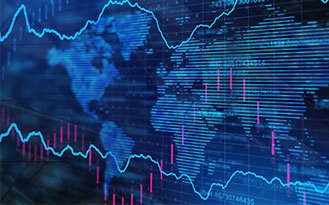Net Zero: Obstacles and Catalysts for Business Climate Action
ERM and EDF+Business conducted interviews and a survey to understand the obstacles companies face when pursuing their climate goals and the catalysts that might help to overcome them.

Chris Ayres, Chief Customer Officer for OPEX, an ERM Group Company spoke with Kathryn Evans, Business Engineer for INEOS FPS, and Frazer Smith, Business Manager for INEOS FPS, about the chemical company’s net zero journey.
Chris Ayres: Who is INEOS and what business unit do you work in?
Kathryn Evans: INEOS is a privately owned global chemicals company that manufactures products that go into everyday items such as pigments, solvents, polypropylene, propylene, ethylene, polyethylene, etc. The two of us work within INEOS’ Forties Pipeline System (FPS) business unit, which is an oil and gas transportation business that enables oil and gas from North Sea fields to be transported to Grangemouth in central Scotland and on to market.
Frazer Smith: INEOS FPS sits within the wider group of companies, forming part of INEOS Industries.
CA: How did INEOS FPS decide to adopt a net zero emissions goal?
FS: We’ve always been focused on efficiencies, reducing energy consumption and emissions. It makes business sense. The goal of being ‘net zero’, by 2045 in Scotland (2050 for the UK as a whole), brings with it the renewed focus and drive to deliver our commitment to a road map that lays out the steps we will be taking as a business to achieve this outcome.
There is support across our value chain for net zero action as well as with our stakeholders, regulators, and funders. As such, the question of what businesses like INEOS FPS are doing to meet and support the net zero target is now very relevant to us.
It is also worth reflecting on the fact that all the business units in the INEOS Group need to take steps to reach net zero and each has developed a road map to meet that target.
CA: How do your customers and other partners fit into your net zero journey now that you have set a target?
FS: Most of our customers are working on their own net zero journeys and the challenges that come with them. We all seem to be talking the same language here and there is a common will to deliver, albeit at different paces.
CA: You have a vision for the speed at which you want to decarbonize, but that won't always be in harmony with your partners or customers, will it? Perhaps customers might want you to move faster and other partners might want you to move slower. Is this something you have encountered or is there a broad consensus in terms of the pace.
FS: There is broad consensus that supports the decarbonization discussion. While some will work at a different pace from others, we all have the same goal and target in mind – to be net zero by 2045.
CA: On a decarbonization journey, setting targets is one thing. But actually delivering against those targets is turning that promise into action. The promise is relatively cheap, whereas the action is more expensive. That is where things start to get more interesting, because action generally is proportional to investment.
FS: We believe that we have a proven track record of delivering on our commitments. When we set our mind to undertaking a challenge, we do our utmost to achieve it.
CA: What role has technology (from hardware to software) played in your net zero journey and is it different to the way it fits into your other business priorities?
KE: Data driven technologies are proving to be essential to our net zero journey, by making data more accessible across the business. This allows us to compare how we have performed in the past and makes data accessible for the Board and senior management to ask questions like: “Where can we make improvements and what are we doing to help them happen?”
CA: You talked about being on the leading edge of technology. Would you say that applies broadly to the deployment of all technologies (digital included) specifically against your net zero ambition?
KE: I would. As part of the net zero road map, many parts of INEOS are assessing a range of technologies across their assets. With carbon capture and utilization, for example, we see it as additional piece of technology that may have potential in the future day-to-day running of INEOS FPS. Overall, we are trying to see where we can employ technologies across the entire net zero picture to help with each part of our journey.
CA: How are you engaging the whole organization in your net zero journey so that it is not just the sustainability officers’ remit, but the operations and the commercial team’s remit as well?
FS: Engaging the INEOS FPS organization remains an enduring priority.
INEOS has set up a centralized energy network that has brought all the INEOS businesses together to develop their road maps and better understand what that means for INEOS as a group.
We recognize the need to enfranchise our employees behind the net zero journey as part of running a successful business. We used the energy network concept as a blueprint to create both a Grangemouth Energy Network (GEN), which brings together expertise from across the INEOS businesses at Grangemouth; and a Young Climate Energy Network (YCEN), which is composed of young and bright talents in Grangemouth who are empowered to contribute climate action ideas to the business.
Ideas generated by our energy networks around waste management and recycling for example, are fed back into the business and to employees to say, “this idea came from here, and we've done this because of it, and it has had this improvement.”
CA: I am pleased that you talked about the commitment to action as well. You get these groups talking. You empower and enfranchise employees, and then you take the ideas they produce and do something with them to deliver an outcome. It drives a virtuous cycle.
FS: It definitely does. We do not want our employees to hear about INEOS FPS’s climate action for the first time when our quarterly or annual results are published. While our net zero journey is a work in progress, we are still advancing.
CA: I want to come back to balancing priorities again. How do you ensure that climate action, a relatively new priority, is proportionately engaged across the organization? How has INEOS struck a balance between key production and throughput with safety and sustainability?
FS: Sustainable operations is part of our overall business strategy. Everyone understands that, and everyone knows they have a role to play in delivering on that. I would go out on a limb here and say that we also do not necessarily see profit and purpose as mutually exclusive in this regard.
KE: I would reiterate the same point, but I also think it is understood that if we want to have a long-term business, sustainability is key. At INEOS FPS, sustainability is emphasized from the top down, and it is discussed at the same time that we talk about health and safety and other priorities. Overall, we are increasingly focused on sustainability and our whole organization understands that it will be a major part of our business going forward.
CA: How are you using digital technologies to integrate sustainability into your day-to-day operations and to make it a behavior rather than just an idea?
KE: OPEX’s emissions.AI has been a big help with this. We make many of our decisions based on the make-up of the product coming down the pipeline and emissions.AI helps us make these decisions more easily. It helps by providing answers to questions like:
How does performance compare if we're running with this piece of equipment or that piece of equipment?
Is there an emissions difference between the two?
Is there a benefit to be had from running one over the other?
emissions.AI also allows us to look at the energy and emissions cost of keeping equipment online. If equipment were to be taken offline, we might have additional flaring that takes away from any emissions reductions. emissions.AI allows us to quickly quantify each approach and decision from an environmental perspective because we have data readily available.
CA: What are your thoughts on the challenges of how difficult it is, because of the significant time and effort involved, to say to people who are very busy within streamlined operational scenarios that they need to start considering sustainability factors too?
KE: People are busy. However, if you present somebody with enough information, but not too much so as to overwhelm them, they are likely to be more receptive. Part of my job is to act as a bridge to help people understand why sustainability is important. With emissions.AI, for example, I help them see how the technology fits into their roles, how they are likely to use it, and how it fits into our broader sustainability goals.
CA: So, you have commercially- and sustainability-driven imperatives that need to be communicated to different parts of your organization. You've already made that investment in your team. Is that something you've made a conscious effort to do?
KE: Yes, we have. I have worked in our technical team before. I've been part of teams running the plant and making those commercial and sustainability decisions. As such, with any new technology, I understand how it will best fit into what teams are doing. So, when I'm talking to a technical manager about how the commercial team thinks this technology can be utilized, it's coming from a place of understanding of how it fits in. I think emissions.AI has been adopted more effectively because of this experience.
Our technical team is working on many big CAPEX projects that will have a large effect on our emissions output. By helping identify efficiency opportunities, emissions.AI fits into that process, and having the knowledge of what the technical team was doing and how improvements can be made has helped with rolling the technology out.
CA: What are the key technology deployment lessons you have learned that have helped move your net zero journey from promise to action?
KE: One lesson is stakeholder engagement and involving the people who will be using the technology as early as possible. For example, emissions.AI helps us track how much flaring results when we make certain operational changes, which we can then communicate to the technical team to remember for the future. This helps us make emissions reductions easier going forward.
Further, it will help us make informed decisions on smaller questions we may not have considered previously, like, “does switching from pump A to pump B have an impact on our emissions?”
CA: I am interested in how you navigate the organizational temptation to say “you know, I'm not part of the sustainability team. I'm part of the operations team. I'm going to keep doing what I'm doing. And then one day, somebody's going to come in and take 50% off our carbon emissions.”
KE: It comes back to embedding sustainability as a priority across the business. You need to communicate that sustainability is important to everyone now, not just the sustainability team. I get that in the past the operations team may say that “you know, my job is to keep this plant running and that's what I do and the sustainability team can worry about sustainability”. But I think we have seen a shift where it is now clear that sustainability is part of our strategy and that it is everyone’s focus.
FS: To borrow a phrase from the INEOS Grenadiers cycling team, it’s a marginal gains approach and when you aggregate the marginal gains, you are more successful than you would have been otherwise. I think the one thing we can improve upon in the future is how we get buy-in from key personnel at the start when we deploy technology. We need to ensure that they see it as something that helps demonstrate that their instinctive views [about the most sustainable way to operate the facility] are correct.
What emisions.AI is doing is streamlining the audit trail that we will have for the decarbonization decisions that need to be made. Because they do need to be made.
CA: For someone starting or is earlier on their net zero journey, what key pieces of advice would you recommend people pursue to ensure as smooth a journey as possible?
FS: Delivery and delivery and delivery!
We need to ensure that we are not simply paying lip service to climate action. It's not that some people are not convinced that it is needed, or that they are more worried about the bottom line. People may be paying lip service because they do not know what climate-related targets they should be setting.
Currently, there is not a global standard for decarbonization targets. There is also very little cross-national alignment on carbon taxes and other policy-related action enablers, and my sense is that people may be delaying taking decisive action as a result. That said, I think there is a degree to which one must bite the bullet and look towards implementation. And there is some risk in that of course. There is risk and uncertainty around all of this, which is making it difficult, but that's not a reason to not act.
CA: With that risk is opportunity though. Being able to tell everyone that that your products have a guaranteed carbon footprint because you've invested in measuring, monitoring, and optimizing that footprint - that will put you in a very strong position in the future marketplace.
FS: Businesses across INEOS are being invited to provide input at the European Commission level because we are in the process of delivering on carbon capture storage projects. Rather than talking about it for the past three years, we've got on and done it.
We can also explain to them that promoting certain technologies over others will not work if we need to roll out at scale in a sector like carbon capture and storage.
That's where we get traction as well; being in the room with the policymakers, saying: “this would be a problem, but that could work.”
CA: You have both been brilliant. Thank you for being so transparent and open. Is there anything else you would like to add?
KE: I wanted to reiterate how emissions.AI fits into the other things happening across our Grangemouth site. There's lots of different things that we're looking at; from engaging with universities on projects, engaging with companies that do carbon capture to see how it could work for Grangemouth and that work with technologies around carbon utilization. We have a couple of carbon streams on site that are more concentrated, so there's an opportunity to look at different carbon utilization.

ERM and EDF+Business conducted interviews and a survey to understand the obstacles companies face when pursuing their climate goals and the catalysts that might help to overcome them.

An interview with with Michelle Noack, Climate Transition Director for Dow, about her company’s work to achieve carbon neutrality across its ecosystem by 2050.

Andrew Angle examines five likely implications for business of the SEC’s proposed “Enhancement and Standardization of Climate-Related Disclosures” rule.